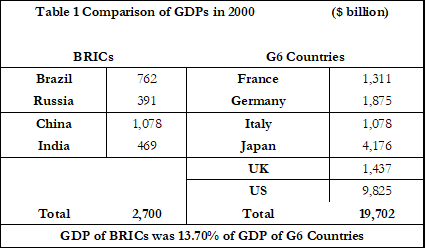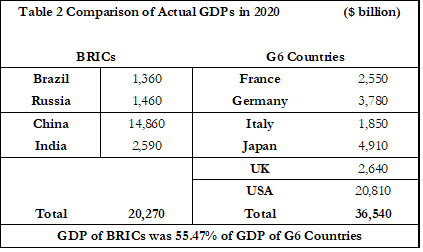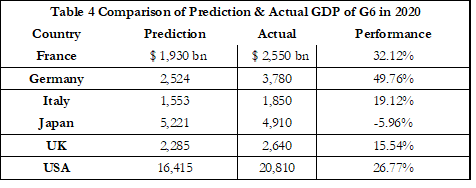In 2003, Goldman Sachs published the ‘Global Economics Paper No: 99’ entitled, ‘Dreaming With BRICs: The Path to 2050’, authored by Dominic Wilson and Roopa Purushothaman, that made predictions about dramatic changes in the global economic order over the next five decades, with the economies of Brazil, Russia, India, and China – BRICs economies – becoming a much greater force in the global economy. A few predictions by the paper were the following:
“… the BRICs economies together could be larger than the G6 in US dollar terms. … Currently, they are worth less than 15%.”
“… China’s (economy could be) larger than the US by 2041 and larger than anyone else by as early as 2016.”
“… the largest economies in the world (by GDP) may not be the richest (by income per capita), making strategic choices by firms more complex.”
They drew the above inferences using models to predict the GDPs and populations of countries. This article presents an analysis of what happened in the two decades since the prediction. The analysis throws up some interesting conclusions.
Comparison in the Year 2000
The GDP of BRICs and G6 countries in 2000 were as presented in Table 1. The figures are based on the model constructed by the authors. They are almost the same as the actual GDP of these countries.

As noted by the authors, the aggregate GDP of BRICs was 13.7% of the aggregate GDP of G6 countries. It was less than one-seventh of that for the six largest economies in the world.
Comparison in the Year 2020
How did the prediction play out in the last two decades? The actual GDP of BRICs and G6 countries in 2020 were as presented in Table 2.

In 2020, the aggregate GDP of BRICs was 55.47% of the aggregate GDP of G6 countries. The percentage was far higher than the predicted 38.9% by the paper. The BRICs countries therefore clearly outperformed the G6 countries over the last two decades.
This should be good news for countries comprising BRICs. A comparison of the predicted versus actual GDPs however reveals a picture very different from the aggregate picture.
Comparison of Actual and Predicted GDP of BRICs
A comparison of the predicted with the actual GDP of BRICs countries is presented in Table 3.

Brazil’s performance was almost as predicted. Russia underperformed by 16.14%. India outperformed by 23.1%. China’s outperformance at 110.18% was stellar. It is evident that the credit for out-performance of BRICs economies vis-à-vis G6 economies over the last two decades can be ascribed entirely to the performance of China’s economy.
Comparison of Actual and Predicted GDP of G6 Countries
A comparison of the predicted with the actual GDP of BRICs countries is presented in Table 4.

Except for Japan, all countries performed better than predicted. Of the remaining five countries, Germany’s performance (49.76%) was the best, followed by France (32.12%), the USA (26.77%), Italy (19.12%), and UK (15.54%).
The Rise of China
The most noteworthy feature of the economic performance of BRICs and G6 countries over the last two decades has been the rise of China as an economic powerhouse. The Chinese economy is 2.75 times the combined economies of Brazil, Russia, and India, and almost the same as the combined economies of Japan, Germany, France, the UK, and Italy. China is likely to overtake the USA much earlier than the predicted year 2041.
The Message for India
In India, the currency is often given to the belief that India will catch up with China’s progress in a few years. Nothing can be further from the truth. In 2000, India’s GDP was 43% that of China. Twenty years later, in 2020, India’s GDP was a mere 17% of China’s GDP.
The relative decline in India’s GDP has occurred with a relative rise in India’s population. In 2000, while China’s population was about 1.27 billion, India’s was 1.03 billion. In 2020, China’s population was about 1.41 billion and that of India was 1.38 billion. As a result, India is even worse off based on per capita GDP. At about $2000 per capita GDP, India languishes at 162nd position in the world.
Clearly, the economic reality for India is very different from what political discourse would have us believe. With a relatively young population, among the larger countries, it may still be possible to accelerate India’s economic progress. This would require us to urgently unshackle the energy and the intellectual capital of the youth in India through proactive policies that support innovation, creativity, and entrepreneurship. The time for action is NOW. Even five years may be TOO LATE.
#BRICS #G6 #GDP #Riseofchina #GlobalEconomics #PerCapitaGDP #India
